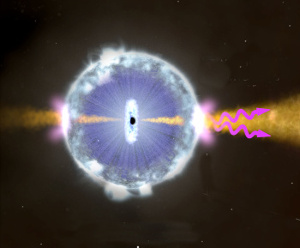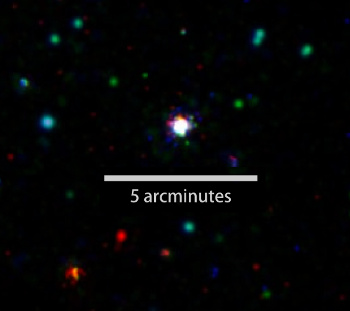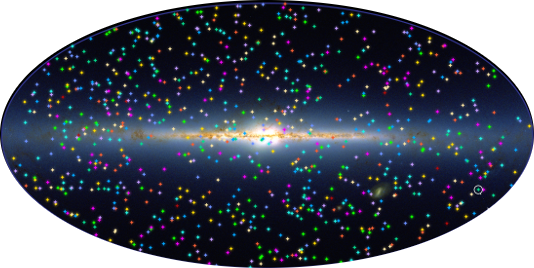A Thousand Gamma Ray Bursts
November 26, 2015
Although
introverts are only likely to think it, but not say it, it's the loudmouth who gets all the attention. The same is true in
astronomy. While our modern
telescopes can image nearly everything in the
universe, only the
brightest sky objects got attention in the past.
Gamma ray bursters are the most
energetic objects in the universe.
GRB 080319B, a gamma ray burster detected on March 19, 2008, by
NASA's Swift satellite gamma ray observatory, peaked at an
apparent magnitude of 5.8. Correcting for its distance of 7.5 billion
light years from
Earth results in a huge quantity of
energy.
If the GRB 080319B burst was
isotropic,
radiating equally in all directions, the calculated energy release is close to the
rest mass of our
Sun; that is, it's the
E=mc2 equivalent of the Sun's
mass converted to energy. It's more likely, however, that these bursts are mostly directional (see figure). Still, such
phenomena demand serious attention. I wrote about gamma ray bursters in several previous articles (
Dearth of Dyson Spheres, May 21, 2015,
Gamma Ray Bursts and the Fermi Paradox, March 19, 2015,
Gamma-Ray Burst GRB 130427A, December 11, 2013, and
The Ionosphere, May 13, 2013).

In the most common type of gamma ray burst, a black hole is formed through the collapse of a massive star. This collapse sends out a jet moving at nearly the speed of light, generating radiation as it collides with material in the vicinity.
(Modified NASA Goddard Space Flight Center image.)
All discovered gamma ray bursters have been located outside our
Milky Way galaxy. They're rare, with just a few expected per
galaxy per million years. This is fortunate, since a pulse of such energetic gamma rays close to the Earth would likely
extinguish all life on our
planet. Such a burst may have affected the
evolution of life on Earth, and gamma ray bursters might limit the number of
intelligent species in the universe.[1]
Observational astronomy is built on
surveys and huge
data sets. A major milestone has been reached for data on gamma ray bursters with the
Swift satellite X-Ray Telescope having detected its one thousandth gamma ray burst,
GRB 151027B, on October 27 of this year.[2] Swift, launched on Nov. 20, 2004, is managed by NASA's
Goddard Space Flight Center.[2]
Gamma ray bursts are detected at a rate of about two per week, so Swift's eleven years of operation has routinely reached a thousand bursts in its more than 500 weeks of operation.[2] Says Goddard's
Neil Gehrels, Swift's
principal investigator, "The
spacecraft remains in great shape after nearly 11 years in
space, and we expect to see many more GRBs to come."[2]

The white dot is GRB 151027B, the one thousandth gamma ray burst discovered by the Swift satellite X-Ray Telescope. The is a cumulative 10.4 hours composite exposure at various wavelengths.
(NASA/Swift/Phil Evans, University of Leicester image.)
GRB 151027B, which gets its name from the discovery date and the fact that it was the second burst on that day, was found in the
constellation,
Eridanus. The Swift team immediately broadcast the position of GRB 151027B to
astronomers using different X-ray telescopes, and also
ultraviolet,
infrared,
visible light, and
radio telescopes.[2] In this way, the rapidly fading
afterglow of the event is imaged in most of the
electromagnetic spectra. Some bursts have enough optical intensity to be bright enough to be seen with the unaided
eye.[2]
Just five hours into the burst, its location in the sky was visible to the
European Southern Observatory (ESO, Paranal, Chile), where it was examined by the
X-shooter spectrometer of the
Very Large Telescope. This spectrometer, designed to measure light from the infrared through the ultraviolet, allowed an estimate of the distance of GRB 151027B from the Earth, 12 billion light years. This makes the burster one of the most distant discovered.[2]
By such a coordinated effort, the distance to about 30% of Swift bursters has been determined. The distance record-holder is
GRB 090429B at 13 billion light years.[2] The capabilities of Swift extend beyond gamma ray bursters. Multiwavelength observations of a variety of astronomical objects, such as
quasars and energetic galaxies called
blazars, are also done.[2]

Map of the first thousand gamma ray bursts detected by the Swift satellite. In this map, color-coded by year, the Milky Way, runs across the center and GRB 151027B is circled at the lower right. The background is an infrared view from the Two Micron All-Sky Survey (2MASS). (Image: NASA's Goddard Space Flight Center and 2MASS/J. Carpenter, T. H. Jarrett, and R. Hurt. Click for larger image)
References:
- Tsvi Piran and Raul Jimenez, "Possible Role of Gamma Ray Bursts on Life Extinction in the Universe," Phys. Rev. Lett., vol. 113, Document No. 231102 (December 5, 2014), DOI: http://dx.doi.org/10.1103/PhysRevLett.113.231102. An arXiv preprint is available here.
- Francis Reddy, "NASA's Swift Spots its Thousandth Gamma-ray Burst," NASA's Goddard Space Flight Center Press Release, November 6, 2015.
Permanent Link to this article
Linked Keywords: Introversion; introvert; astronomy; telescope; universe; apparent magnitude; brightest sky objects; gamma-ray burst; Gamma ray burster; energy; energeti; GRB 080319B; NASA; Swift Gamma-Ray Burst Mission; Swift satellite gamma ray observatory; light year; Earth; anisotropy; isotropic; electromagnetic radiation; radiating; invariant mass; rest mass; Sun; mass-energy equivalence; E=mc2; mass; phenomenon; phenomena; black hole; star; astrophysical jet; speed of light; radiation; NASA Goddard Space Flight Center; Milky Way galaxy; galaxy; extinction; planet; evolution of life; extraterrestrial life; intelligent species; observational astronomy; astronomical survey; data set; X-Ray Telescope; >GRB 151027B; Neil Gehrels; principal investigator; spacecraft; outer space; Phil Evans; University of Leicester; constellation; Eridanus; astronomer; ultraviolet; infrared; visible light; radio telescope; telescope; afterglow; eye; European Southern Observatory (ESO, Paranal, Chile); Very Large Telescope; X-shooter; spectrometer; GRB 090429B; quasar; blazar; Two Micron All-Sky Survey (2MASS); J. Carpenter, T. H. Jarrett, and R. Hurt.